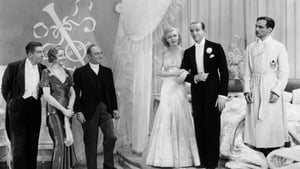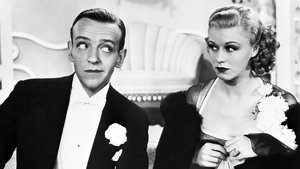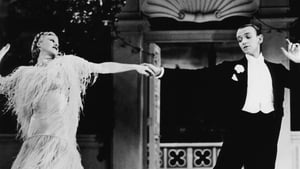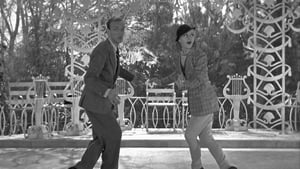Contact: [email protected]
Video Sources 0 Views
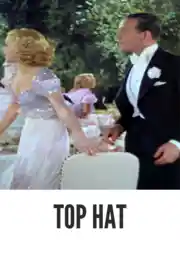
Synopsis
[ez-toc]




Introduction
Top Hat Colorized is a classic film from 1935 that follows the story of Jerry Travers, an American tap dancer who travels to London to star in a show produced by Horace Hardwick. Along the way, he meets and tries to win over the lovely Dale Tremont. The film also includes a cast of memorable characters, such as Hardwick’s valet Bates, the suave fashion designer Alberto Beddini, and Hardwick’s patient wife Madge. Fred Astaire and Ginger Rogers star in this musical screwball comedy that has stood the test of time.
Mark Sandrich directed the film, with Allan Scott and Dwight Taylor credited as the writers and Irving Berlin providing the iconic songs. Two of the songs, “Top Hat, White Tie and Tails” and “Cheek to Cheek,” have since become beloved American classics. The movie, especially the memorable “Cheek to Cheek” sequence, has been fondly referenced in several other films over the years, such as The Purple Rose of Cairo, The Green Mile, and The Boss Baby.
Astaire and Rogers collaborated on a total of nine films at RKO Pictures, including popular titles such as The Gay Divorcee, Roberta, and Follow the Fleet. Among these, Top Hat stood out as their most successful movie, coming in second in global box-office earnings for 1935. Although some experts argue that Swing Time featured superior dance sequences, Top Hat continues to be the duo’s most iconic and recognized film.
In 1990, the Library of Congress recognized the iconic film Top Hat as a significant piece of American history and culture, leading to its inclusion in the United States National Film Registry. The movie was chosen for its artistic merit, cultural impact, and historical relevance, solidifying its place as a timeless classic in the world of cinema.
Read Media File Transfer Agreement: Terms and Conditions
Read FAQ
Top Hat Colorized Plot
When American dancer Jerry Travers arrives in London to star in a show produced by the clumsy Horace Hardwick, he accidentally disturbs Dale Tremont in the room below while practicing his tap dance routine. Angered by the noise, Dale confronts Jerry, leading him to instantly fall in love with her. Determined to win her affections, Jerry embarks on a comedic pursuit of Dale throughout the streets of London.
Dale confuses Jerry with Horace, who happens to be married to her friend Madge. After Jerry’s successful debut in London, he decides to track Dale down in Venice, where she is spending time with Madge and showcasing the latest creations by Alberto Beddini, a stylish Italian fashion designer known for his humorous misuse of words.
Jerry asks Dale to marry him, even though she still thinks he is Horace. Dale is shocked and disappointed that her friend’s husband could act in such a way. As a result, she decides to marry Alberto instead. However, luck is on Jerry’s side when Horace’s English valet, Bates, interferes. Bates pretends to be a priest and performs the wedding ceremony. Horace had sent Bates to monitor Dale and keep him informed.
During a gondola ride, Jerry manages to convince Dale and they return to the hotel, where the previous confusion quickly clears up. The reconciled couple dances into the Venetian sunset to the tune of “The Piccolino”.[8]
Cast
The cast of the film includes Fred Astaire in the role of Jerry Travers, Ginger Rogers as Dale Tremont, Edward Everett Horton portraying Horace Hardwick, Erik Rhodes playing the character of Alberto Beddini, Helen Broderick as Madge Hardwick, and Eric Blore as Bates.
Top Hat Colorized Production
Production of Top Hat commenced on April 1, 1935, with a budget of $620,000 allocated for its creation. Filming took place until June, followed by the first public screenings in July. However, these initial previews prompted the need for some revisions, resulting in approximately ten minutes being trimmed from the film.
The carnival sequence and the gondola parade, which were intended to showcase the grand set, bore the brunt of these cuts. Furthermore, an additional four minutes were excised before the movie’s premiere at the esteemed Radio City Music Hall. Despite these alterations, Top Hat shattered all previous records at the box office and went on to earn a remarkable $3 million during its initial release. It proved to be RKO’s most lucrative film of the 1930s, surpassing even the financial success of Mutiny on the Bounty, making it the highest-grossing film of 1935.
Top Hat Colorized Script development
The development of the script for this film was led by Dwight Taylor, who was the main screenwriter for the first screenplay created specifically for Astaire and Rogers. Initially, Astaire was not pleased with the initial drafts, feeling that they were too similar to “The Gay Divorcee” and that his character lacked charm, sympathy, and humor.
Allan Scott, who was relatively new to the industry at the time, was brought in by director Mark Sandrich to revise the script, with Sandrich providing guidance and input throughout the process. It is rumored that Ben Holmes, Ralph Spence, and Károly Nóti also contributed to the script. The story itself was reportedly inspired by “Scandal in Budapest” by Sándor Faragó and “A Girl Who Dares” by Aladar Laszlo.
The Hays Office, known for its strict censorship guidelines, only required a few minor alterations to be made in Top Hat, one of which resulted in the iconic line of dialogue: “For the women the kiss, for the men the sword.” Originally, the line read: “For the men the sword, for the women the whip.” This change was significant and has since become one of the most frequently quoted lines from the film. Reflecting on his involvement in the creation of Top Hat, Taylor fondly recalled the sense of childlike excitement he shared with Sandrich and Berlin.
Together, they embraced a carefree and whimsical approach to the film, which can be summed up in the word “inconsequentiality.” Taylor left RKO a year later, and upon parting ways, his colleague Mark predicted that he would never again witness such a significant manifestation of his own persona on the screen. However, when the film was released, it faced harsh criticism from many reviewers who accused it of being a mere rehash of The Gay Divorcee.
Top Hat Colorized Musical score and orchestration
Composer Irving Berlin’s first complete film score since 1930 was accompanied by a unique contractual agreement. Berlin managed to retain the copyrights to the score and secured a guarantee of ten percent of the profits if the film surpassed $1,250,000 in earnings. Interestingly, eight songs from the original score were deemed irrelevant to the film’s storyline and were consequently discarded.
Among these rejected songs was “Get Thee Behind Me, Satan,” which would later find its place in Follow the Fleet (1936). However, the remaining five songs that were selected for the film turned out to be major hits. In fact, during the September 28, 1935 broadcast of Your Hit Parade, all five of these songs were included in the top fifteen songs of the week.
Fred Astaire remembered how this achievement played a significant role in boosting Berlin’s diminishing self-assurance. Despite having performed to Berlin’s melodies on stage since 1915, Astaire had never crossed paths with the renowned composer until this particular movie. This encounter sparked a lifelong friendship, with Berlin becoming the composer who contributed to the highest number of Astaire’s films, a total of six. Berlin expressed his admiration for Astaire’s influence on his work, stating that without him, he would never have written Top Hat, and that Astaire’s presence made him feel incredibly confident and secure.
Due to Berlin’s inability to read or write music, he relied on an assistant to help him create piano parts for his compositions. Hal Borne, who was Astaire’s rehearsal pianist, took on this role during the production of Top Hat. Borne recalled late night sessions with Berlin at the Beverly Wilshire Hotel, where they collaborated on crafting the piano parts for the songs.
Berlin would hum the melodies, and Borne would play them on the piano, improvising and creating the parts on the spot. Their work was then orchestrated by a team of skilled individuals, including Edward Powell, Maurice de Packh, Gene Rose, Eddie Sharp, and Arthur Knowlton, under the supervision of Max Steiner. This collaborative process allowed Berlin to bring his musical vision to life despite his lack of formal musical training.
Berlin’s film in Berlin disregarded several American songwriting norms, particularly in the hit songs “Top Hat, White Tie and Tails” and “Cheek to Cheek”. These unconventional choices caused quite a stir in Hollywood, as the film’s score quickly became the topic of conversation.
Top Hat Colorized Set design
In an Astaire-Rogers film, the Big White Set, a grand Art Deco-inspired creation, was a significant investment in the production budget, and Top Hat was no different in this aspect. The set featured a winding canal with staircase bridges at one end and a flat bridge at the other, where Astaire and Rogers famously danced in “Cheek to Cheek”.
Adjacent to this bridge was the main piazza, a massive stage covered in red bakelite where “The Piccolino” was performed. This elaborate set was a whimsical depiction of the Lido of Venice, complete with dance floors, restaurants, and terraces, all adorned in vibrant candy-cane colors and with the canal waters dyed black. The opulent Venetian interiors were also a departure from authenticity, instead reflecting the glamorous Hollywood aesthetic of the time.
Carroll Clark, who was overseen by Van Nest Polglase, served as the unit art director for nearly all of the Astaire-Rogers films, with the exception of one. In his role, he led a talented team of designers in creating the stunning scenery and furnishings for the iconic film Top Hat.
Top Hat Colorized Wardrobe: The “feathers” incident
Even though Bernard Newman was technically in charge of dressing the stars, Rogers had a strong passion for dress design and make-up. She was especially determined to use her own creation for the “Cheek to Cheek” routine. Despite facing opposition from the cast and crew, Rogers stood her ground and insisted on wearing the dress she had designed. She was used to standing alone and facing challenges, but she found comfort in knowing that her mother was there to support her during the confrontation with the front office, Fred Astaire, and Mark Sandrich.
The painstaking process of sewing each individual ostrich feather onto the dress was so laborious that Astaire, who typically had a say in his partner’s costumes during rehearsals, didn’t see the finished product until the day of the shoot. To his dismay, the dress shed feathers in abundance with every movement, causing Astaire to liken it to a chicken under attack by a coyote. This unexpected turn of events led to a heated moment on set, with Astaire expressing his frustration and Rogers breaking down in tears.
Lela, Rogers’ mother, fiercely defended her daughter in the face of Astaire’s outburst. Despite efforts by seamstresses to rectify the issue, feathers continued to float around the dancers and litter the dance floor during filming. In an attempt to make amends, Astaire and Pan presented Rogers with a gold feather for her bracelet and sang a playful parody of a popular tune for her.
I have a strong aversion towards feathers, to the point where it renders me almost speechless. The mere sight of them prevents me from finding the joy and contentment that I desire. It feels as though those feathers are mocking me as they gracefully dance in close proximity to each other.
Following that, Astaire gave Rogers the nickname “Feathers,” which was also the title of a chapter in his autobiography. He humorously depicted this experience in a song and dance performance alongside Judy Garland in the film Easter Parade (1948).
Astaire was known for his impeccable sense of style and often handpicked his own wardrobe for his performances. Many credit him with revolutionizing men’s fashion in the 20th century. In one iconic routine, he showcased his signature look – a soft-shouldered tweed sports jacket, button-down shirt, bold striped tie, gray flannel trousers, silk paisley pocket square, and suede shoes. This ensemble epitomized nonchalant elegance and has continued to influence designers like Ralph Lauren to this day. Astaire’s stylish and modern approach to dressing stood out from the traditional spats, celluloid collars, and homburg hats favored by other leading men of his time.
Top Hat Colorized Musical numbers and choreography
The choreography in the film, which was expertly assisted by Hermes Pan, primarily focuses on the creative utilization of tap dancing to produce an abundance of noise. Astaire’s character in the film is portrayed as having a peculiar condition, as referred to by Rogers, where he sporadically finds himself compelled to dance. The film introduces its tap dancing theme when Astaire unleashes a powerful torrent of taps upon the unsuspecting and sleepy patrons of a London Club. Throughout the film, there are a total of eight captivating musical numbers that showcase the incredible talent and skill of the performers.
In the captivating “Opening Sequence” of the film, as soon as the iconic RKO logo graces the screen, the audience is transported to a mesmerizing world where Fred Astaire takes center stage, elegantly displayed from the waist down. With a polished stage floor as his canvas, Astaire effortlessly glides and taps his way into our hearts, accompanied by a talented male chorus who gracefully twirl their canes in perfect synchronization. As the scene pauses, Astaire’s name magically materializes, further emphasizing his star power.
And just when we think the spectacle couldn’t get any more enchanting, Ginger Rogers gracefully joins Astaire on the stage, effortlessly matching his every move, creating a mesmerizing dance duo that leaves us in awe. As the picture dissolves, a tantalizing glimpse of a top hat is revealed, hinting at the magical moments that await us in this captivating cinematic journey. It’s worth noting that a similar genius concept was ingeniously utilized in the opening sequence of the timeless classic, The Barkleys of Broadway (1949).
The second song in the film is called “No Strings (I’m Fancy Free)”. After retiring to his hotel suite, Horton suggests that Astaire should consider getting married. However, Astaire expresses his preference for remaining a bachelor. The song, which was originally conceived by scriptwriter Dwight Taylor and included in the earliest drafts of the script, seamlessly comes to life in the middle of a conversation. Astaire sings the song twice, and during the final phrase, he jumps into a ballet move accompanied by leg beats.
He then proceeds to perform a short solo dance, starting with tap shuffles in place and gradually increasing in intensity and volume as he moves around the room, incorporating traveling patterns and rapid-fire heel jabs.
At the end of his dance, Astaire playfully tours the suite, even using his hands to beat on the furniture. However, as he reaches the center of the room, the camera pans down to reveal Rogers in bed, awake and annoyed. Rogers then makes her way upstairs, while Horton deals with complaints from the hotel management over the noise. Astaire includes these interruptions into his routine by startling Horton with a burst of taps and then ostentatiously escorting him to the telephone.
As Horton leaves to investigate, Astaire continues his energetic dance, occasionally pretending to be horrified by his reflection in a mirror, a nod to his belief that the camera didn’t always capture his face favorably. The routine concludes with Astaire dancing with a statue, only to be interrupted by Rogers’ entrance. This scene, reminiscent of previous films like “The Gay Divorcee” and “Roberta,” exemplifies Astaire’s knack for unintentionally provoking Rogers’ animosity, only to ultimately win her over and break down her resistance.
In the enchanting scene of “No Strings (reprise)”, Rogers finds herself frustrated and storms upstairs to voice her complaints. However, upon returning to her room, she is met by Astaire, who is still determined to dance. Undeterred by her previous frustration, he playfully appoints himself as her “sandman”. With a clever twist, he sprinkles sand from a cigarette receptacle, creating a dreamlike atmosphere. As the sand falls gracefully, he mesmerizes not only Rogers but also Horton, and even himself, with an exquisite sand dance.
The melody softly fades away, creating a peaceful ambiance that has captivated dance enthusiasts and garnered immense praise from critics. This remarkable scene has also become a source of inspiration for humorous screen parodies, showcasing its lasting impact and endearing charm.
According to Mueller, the dance is characterized by flirtation and incorporates two choreographic techniques commonly seen in classical minuets: sequential imitation and touching. Initially, the imitation is somewhat mocking in nature, but it gradually evolves into a more casual exchange between the dancers. Ultimately, the dance ends on a note of true cooperation. Throughout most of the two and a half minute routine, the duo appears to hold back from physical contact, but in the last thirty seconds, Rogers invites Astaire in with a crook of her elbow. The dance routine is a delightful blend of comedy and romance, featuring various innovative elements such as hopping steps, tap spins with barrages, loping, and dragging steps.
The spirit of equality between the dancers is evident not only in their energetic performance but also in Rogers’ choice of masculine attire. The dance concludes with a friendly handshake between the two, further emphasizing the sense of equality and camaraderie. In the scene “Isn’t This a Lovely Day (to be Caught in the Rain)” from the film, Rogers and Astaire find themselves caught in a thunderstorm while out riding. Seeking shelter, they both end up in a bandstand where they engage in a conversation about clouds and rainfall.
However, the conversation quickly transforms into Astaire performing a rendition of one of Berlin’s most esteemed creations. As Astaire sings, Rogers’ demeanor towards him starts to soften, which is evident to the audience even though he sings to her back. The subsequent dance that follows is meant to convey Rogers’ change in attitude towards Astaire.
